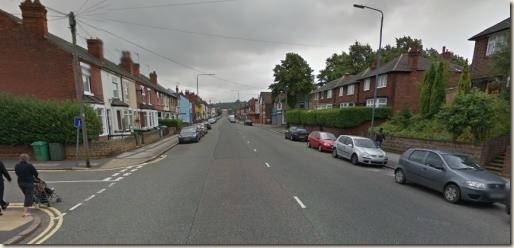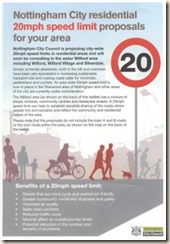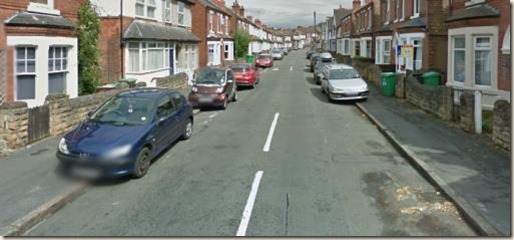The local comedians who pass themselves off as councillors in Nottingham appear to have very short attention spans to go with their complete lack of any  common sense whatsoever.
common sense whatsoever.
I have frequently mentioned on this blog that on top of the total waste of money that is the tram, and its multitude of long-term road closures, they are adding additional road closures for other purposes on a daily basis, making it impossible to get through from one side of the City to the other. Even when a route is open, there is tons more traffic using it because it can’t go via it’s usual alternative route, which will be blocked.
Well, these comedians are now in the process of introducing blanket 20mph speed limits across Nottingham. An “information leaflet” they sent out – given to me by a pupil – can be seen (and downloaded) by clicking the image on the left.
To start with, the fact that they say that they are “proposing” these changes is a complete joke. They’re already doing it. And they ARE going to do it, everywhere, no matter what you or me might think or say. They don’t give a damn about anyone’s opinion unless it fits in with the one they already have. That’s why they will glibly quote residents as having said that they “support lower speed limits”, and yet ignore any opposing views.
Get it into your thick skulls, Nottingham City Council:
20mph is TOO SLOW on many roads, and certainly on some of those you have included in your blanket!
Most of the data they keep quoting – when they do actually use any data – relate to the likelihood of death if hit by a car travelling at 20mph or 30mph. Yes, if you’re hit by a car travelling at 30mph you’re more likely to die than if you’re hit by one going 20mph. That’s why 20mph speed limits make perfect sense outside schools, where the likelihood of a poorly-raised or badly supervised child running out is greater.
However, putting a 20mph limit on roads like Haydn Road – shown below – is the height of stupidity. It is really just too dumb for words.

The problem for the driver is that on these larger roads – and especially long straight ones like Haydn Road – sticking to 20mph is difficult. Cars are simply not designed to go at that speed all the time, and it is easy to go over. That means the driver will be spending time looking at his or her speedometer, so the likelihood of an accident could increase – even if it isn’t a fatal one.
Another problem is other drivers. The vast majority do not observe 20mph zones as they would 30mph ones, so someone who is actually doing 20mph will get tailgated and overtaken often – and believe me, if I’m in a 20mph zone I can guarantee that 90% of other drivers WILL tailgate or overtake. It happens over in Aspley, and now it happens in Sherwood.
These drivers aren’t notching it up to 60 or 70 or anything once they pass you. They’ll continue to drive at less than 30mph – but they simply don’t stick to 20mph, and they get impatient if they’re behind anyone who does. And this, too, can increase the risk of an accident – not just the overtaking, but the frustration created.
My pupils almost always feel pressured by this. They say so in no uncertain terms, and it leads them to make mistakes, because they’re looking in the mirror instead of looking ahead. They will still feel pressured once they pass their tests – when I’m not there to use the dual controls. For God’s Sake, I feel pressured – and I’ve been driving over 30 years!
So that then raises the issue of enforcement. Enforcing these 20mph limits effectively will cost a fortune, and to finance that, more people will need to be caught. Applying the 10% + 2mph guideline means going over the limit and getting ticketed is much easier than it is in 30+ zones, and none of the borough councils are in any way averse to deliberately twisting the rules to make money. Last year, for example, I accidently typed “62” instead of “61” into a parking ticket machine in West Bridgford and got a PCN as a result. The scumbags wouldn’t accept my argument that the parasite in the uniform that was too big for him had seen me buy the ticket in the first place, and wouldn’t respond to my subsequent complaints.
THIS is what they will end up doing with these 20mph zones if they try to enforce them. They will screw motorists even more. And that’s only if it remains a civil matter (involving PCNs). If the police are dragged into it and Fixed Penalties are involved, peoples livelihoods could be at stake – just to massage the egos of a bunch of politically correct teenage bureaucrats with ideas above themselves.
Just staying with Haydn Road for a moment, it’s also worth pointing out that all the side roads joining it have got speed bumps on them, and are so narrow that you can’t do more than 20mph anyway (and people seldom do). Percival Road, shown below, is a prime example – they’re all like this, and the picture doesn’t do it justice as there are usually far more parked cars than that.
Yet the Council has already spent thousands erecting pointless signs on these roads – a cost above and beyond that of installing and maintaining the speed bumps over the years. And this is before their “consultation”, you understand. So we’ll just have to pretend that there is a cat in hell’s chance of them realising they’re wrong and taking the signs down.
What of the accident statistics for these areas which are destined to be smothered with 20mph blankets? Maybe once every few years someone will get knocked over – and that’s a worse case scenario – but that’s all. It’s not like there is carnage all year round, and along miles and miles of roads.
So what, then, of the propaganda being spewed by the City Council? In that brochure, they say:
The Wilford area… has a mixture of shops, schools, community centres and residential streets.
It’s a pointless statement that could be applied to any road in the UK. But it continues:
A 20mph limit can help to establish sensible sharing of the roads where people live and socialise and reflect the community and residential nature of the area.
Someone please pass me the sick bag! What are they suggesting? That people should walk around on roads regardless of traffic? They already do that in neighbourhoods where a single helix in their DNA is as high up the evolutionary ladder they get, and that’s where those bloody accidents I mentioned come from in the first place. It’s all wishy-washy bullshit, designed to appeal specifically, for example, to people whose brains have been turned to jelly because they’ve just had a baby and who “want to see safer roads” for when little Kylie or Jason grows up. It’s a little ironic, since Kylie or Jason will likely grow up either to be a statistic, or to make the statistics themselves – all because of the ineffectual way they’ve been brought up in the first place. And even more ironically, those very parents who want “safer roads” will be the worst offenders when they start taking little Kylie or Jason to school!
That the scheme is a foregone conclusion can be seen in the statement:
A formal, written consultation will take place in October 2013 where you can have your say on which roads should be included or excluded in this scheme.
Can you see that? Residents will be consulted over is which roads will be included – not whether or not the scheme itself should go ahead at all. Nottingham City Council have no intention of backing down on this, no matter what anyone says. All they want is to be able to sift the responses for the ones they like the sound of, and to oppose or smear those they don’t.
Is there any conclusive evidence that 20mph limits actually work? Well, no. However, most councils across the UK are introducing these 20mph limits, and their supporting evidence is based wholly on the circular argument that it must work because everyone else is doing it. Nottingham City Council is no exception – it’s only evidence for 20mph being beneficial appears to be that Newcastle has done it. And somehow, Newcastle has come to the startling conclusion that accidents have fallen between 20% and 60% in streets where 20mph has been imposed. No mention of the type of road, or the times of day – just this idiotic blanket statement that the fools at Nottingham’s City Council can pounce on without having the slightest clue if it’s true or not, or why.
If it were true, then 20mph limits should be introduced – and it would be hard to argue. But the Newcastle scheme only started in 2008, and even then it only reached full blanket level at the end of 2011. Accident statistics are notoriously complex, and no one – anywhere – understands them fully. So there is no way that a mere 18 months of data can be used to definitely prove that 20mph limits result in massive reductions in accidents. I would lay odds that some of the roads in Newcastle which haven’t been restricted have also seen reductions in accidents. That’s what happens – the numbers go up and down all by themselves, and cannot be attributed to single events like the introduction of lower limits, and it is misleading and unprofessional to attempt to do so.
And then, what of the places Nottingham City Council is targeting? If you look at the RoSPA site on this topic, it says of 20mph limited areas:
20mph limits are most appropriate for roads where average speeds are already low, and the guidance suggests below 24mph. The layout and use of the road must also give the clear impression that a 20mph speed or below is the most appropriate.
The Department for Transport (DfT) also advises 20mph limits on roads where the average speed is already less than 24mph. The decision by the Council to apply a 20mph limit to Haydn Road is clearly in breach of this. Haydn’s original speed limit was 30mph, and the layout (width) most certainly did not make it a “low average speed” road. Absolutely nothing, therefore, can justify applying a 20mph limit to it, and Nottingham City Council has just steamrollered over the very guidance it quotes in support of its draconian behaviour. The situation it has created is therefore potentially much more dangerous.
Another council doing this is Bristol. Interestingly, the police comment:
We do not oppose the introduction of 20mph schemes but encourage all to look at other ways that we can promote reducing speed limits effectively.
As with any other speed limit, 20mph zones will be treated in the same way in that enforcement will not be routine but intelligence led. Where there is evidence of excessive speed, we will take action where appropriate.
That first sentence is very telling. You see, from what I can gather, Nottingham City Council IS going to be trying to enforce these limits – and especially on Haydn Road! And yet I cannot see how they’re going to manage to get the police to do it, which means it will remain a civil matter. Quite frankly, I don’t think they know how they (the Council) are going to enforce it.
I’ll just say again:
20mph is TOO SLOW on many roads
 voiceovers, or Practical Driving Tests using an interpreter. This action follows the consultation carried out earlier this year, the results of which can be read here.
voiceovers, or Practical Driving Tests using an interpreter. This action follows the consultation carried out earlier this year, the results of which can be read here.


 instructor”.
instructor”.